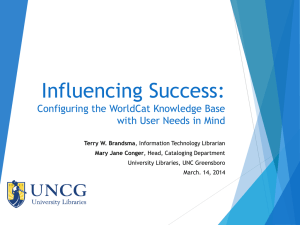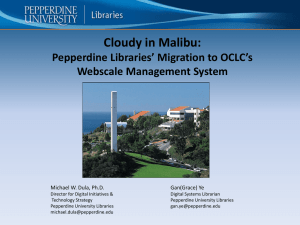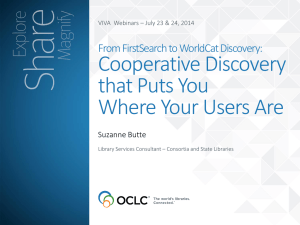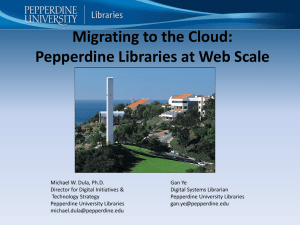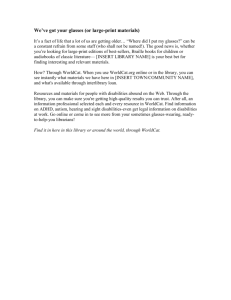Symphony Questionnaire
advertisement
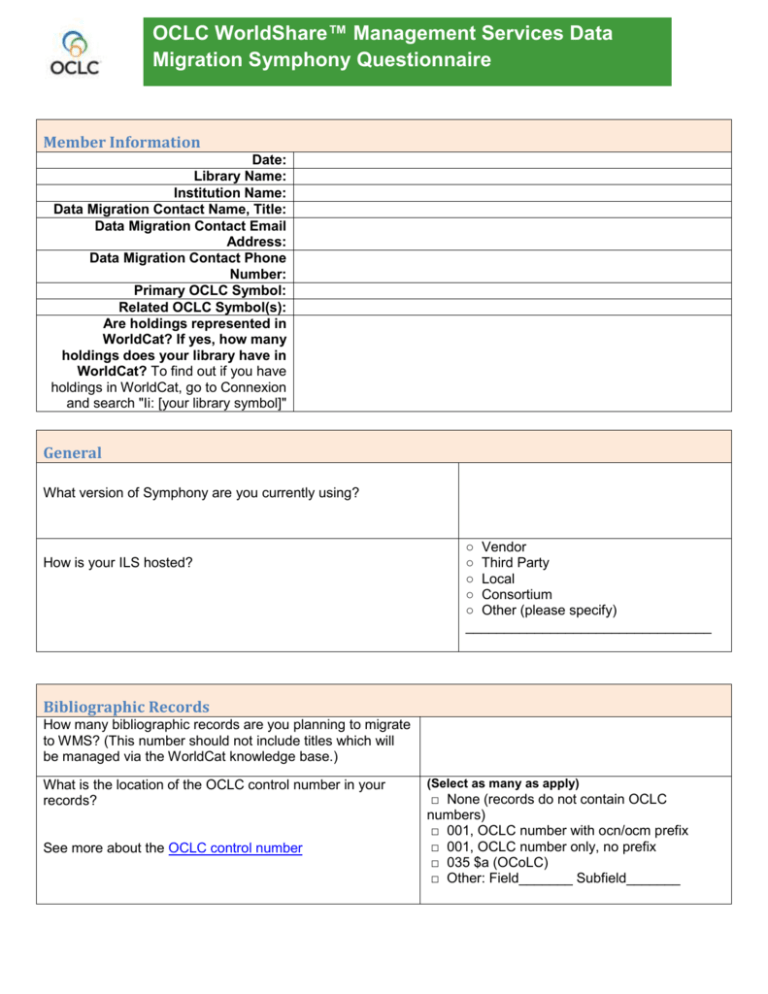
OCLC WorldShare™ Management Services Data Migration Symphony Questionnaire Title Member Information Date: Library Name: Institution Name: Data Migration Contact Name, Title: Data Migration Contact Email Address: Data Migration Contact Phone Number: Primary OCLC Symbol: Related OCLC Symbol(s): Are holdings represented in WorldCat? If yes, how many holdings does your library have in WorldCat? To find out if you have holdings in WorldCat, go to Connexion and search "Ii: [your library symbol]" General What version of Symphony are you currently using? How is your ILS hosted? ○ Vendor ○ Third Party ○ Local ○ Consortium ○ Other (please specify) ________________________________ Bibliographic Records How many bibliographic records are you planning to migrate to WMS? (This number should not include titles which will be managed via the WorldCat knowledge base.) What is the location of the OCLC control number in your records? See more about the OCLC control number (Select as many as apply) □ None (records do not contain OCLC numbers) □ 001, OCLC number with ocn/ocm prefix □ 001, OCLC number only, no prefix □ 035 $a (OCoLC) □ Other: Field_______ Subfield_______ During the batchload process, the default matching for WMS libraries qualifies the OCLC number by the derived title. Is there any reason we should not use the derived title qualifier for your migration? ○ Yes, use title qualifier ○ Unsure, please discuss further with your Implementation Manager (option OCLC number matching) For Symphony libraries, the Local System Control Number (LSN) is generally found in the 001 or 035 field/sub-field a of the bibliographic record upon extraction. Please provide an example LSN from your collection. WMS data migration requires that bibliographic data be sent in MARC format. Please be aware that exceptions to the MARC format will require conversations with your Implementation Manager. If you have exceptions please list them here. What is the format for your bibliographic records when they are extracted from your ILS (MARC21, UNIMARC, INTERMARC, etc.)? What is the character set encoding for your bibliographic records (MARC-8, UTF-8 Unicode, etc.)? The WMS data migration process requires extracted bibliographic records that include item information (location, barcode, call number). Please provide a table of values that includes all relevant sub-fields, descriptions and examples for item information in the bibliographic record upon extraction. Your table should be similar to the example below: 999 subfield a c d e f g h i k l m n o p q r s t u v w x Document1 description Call Number Copy number Last activity date date last changed date inventoried times inventoried holding code Barcode (item ID) current location Home Location Library Total charges item comments Price in house charges circulate permanent item type date created volume class scheme item category example CD 285 Pt. 1 1 10/7/2002 2555000136570$ AV Chabot 5 $27.98 Y Y CD 5/9/1991 LC 2 February 8, 2016 Will each bibliographic record contain multiple item fields or will each item have its own bibliographic record when extracted from your ILS? ○ Contain multiple item fields ○ Own bibliographic record Suppressed and Vendor Records ○ Yes, we will exclude our suppressed records ○ No, we understand the suppressed records sent for migration will be discoverable in WorldCat Discovery If you currently maintain records in your ILS that you do not wish to display publicly, such as suppressed records, then you will need to exclude these records from your migration. If you have vendor-supplied records in your ILS, make sure that you have permission to send those records as part of your migration. Visit this site for a list of vendor record sets OCLC has agreements to use their records. Do you have vendor records that are from a set not listed on this site? ○ Yes ○ No If yes, please explain how you have/will request permission to use these records or how you will exclude them from your file. Additional Information Copy Numbers Generally, upon extraction copy information is seen at either the end of the call # or within a specific subfield of the item field. OCLC processes will move the copy to the subfield t of the 852 in the local holdings record. Inconsistent usage of copy numbers may result in OCLC processes not being able to accurately identify when multiple copies of an item exist. Should this occur, some post-migration cleanup by library staff may be required. If copy information cannot be found with the call # upon extraction, OCLC processes will take the copy# from the copy information field (subfield c of the item field). If this is not consistent with your maintenance of copy number, please indicate so here: Classification Scheme Would you like a default classification scheme set for your migrated items? If you prefer to not have a default classification then items will be migrated as Unknown. ○ ○ ○ ○ Dewey LC NLM Unknown Note: Setting a default classification scheme with a 1 or 0 in the first indicator requires call number information be present in the 852 $h of the LHR upon migration in order for validation errors to not occur. Bound-With When two or more separately published works are bound together under one cover or comparable packaging this is referred as bound-with. Document1 3 February 8, 2016 ○ Yes ○ No Do you have “bound-with” records in your catalog? ○ Yes ○ No ○ Not applicable If you do have “bound-with” items, will they be exported with duplicate barcodes? Item Barcodes WMS requires a unique barcode for each item. The barcode field is case sensitive. ○ Yes ○ No Are all of your item barcodes unique? Barcodes cannot begin with an uppercase B and/or U. If you have concerns about this requirement please share them here: Do any of your item barcodes have special characters (any characters other than alphanumerical characters)? If yes, which characters? ○ Yes ○ No Do any of your item barcodes have spaces? Item Notes Do you use item notes? ○ Yes ○ No (Please note: bibliographic notes are covered in the Local Bibliographic Data section) Where will we find your item notes? (Generally upon extraction, item note information is seen in subfield o of the 999 item field, with prefixes of COMMENT, PUBLIC, CIRCNOTE or STAFF. Prefixes can be stripped if requested.) Please provide examples from extracted data. If you use item notes, have your item notes been used consistently over time? If you use item notes, do you want them migrated? If you want your item notes migrated, should they be public or staff notes? Would you like the staff note to pop-up upon checkout/check in? Document1 4 February 8, 2016 Local Holdings in WMS Local Holdings Records (LHRs) are separate holdings records attached to a related WorldCat bibliographic record that provide holdings details beyond your OCLC institution symbol. The OCLC local holdings record structure is based on the MARC 21 Format for Holdings Data In WMS, LHRs house copy-level details and your item information. The call number and location information allow users to find the item in your library and the barcode provides availability information. If you want to retain 856 links, public or private notes, this information will be stored in LHR fields. ○ Yes ○ No How many: To find out if you have LHRs in WorldCat, go to Connexion and search "I4: [your library symbol]" Do you have Local Holdings Records (LHRs) in WorldCat? If yes, how many? LHR Display in WorldCat We cannot add information from the data load to existing LHRs other than a default shelving location, branch, and call number. Retaining existing LHRs will require that you manually add any barcodes for items associated with these LHRs after the migration. Consequently, users will not see availability information for these items until barcodes have been added. If you are unsure whether or not you would like to retain your existing LHRs, let your Implementation Manager know. We can order a report for you which list the records with local holdings attached. The LHRs created as part of the batchload process will include branch, shelving location, barcode, and item information provided by the data and outlined in your scope statement. Do you want to preserve your existing LHRs in WorldCat? Document1 ○ Yes ○ No (Existing LHRs and their ILL deflection policies will be removed by OCLC prior to the start of the 5 February 8, 2016 migration) ○ Unsure ○ Not applicable Do you have the need to preserve any customized 856 links for non-electronic records in a Local Holdings Record? ○ Yes ○ No Example: 856 links added to print records for local digitized dissertations If yes, please provide the URLs of the 856 fields that need to be retained as part of your data migration? Example: In the URL: rchives.university.edu/it=12345, archives.university.edu is the base URL Serials How many serials (titles) do you have and do you barcode titles and/or issues? Generally bibliographic records with item information, volume data is seen at the end of the call # upon extraction. OCLC processes will remove the volume # from the call # during migration and place it in the appropriate sub-field of the local holdings record. If volume information cannot be found with the call # upon extraction OCLC processes will take the volume # from the volume field (subfield v of the item field). If this is not consistent with the way that you have maintained volume numbers historically, please indicate so here: Inconsistent usage of volume numbers may result in OCLC processes not being able to accurately identify when multiple volumes of an item exist. Should this occur some post-migration cleanup by library staff may be required. ○ Yes ○ No Can you send your serials items in a separate file? Marc Format for Holding Data MARC Formats for Holding Data (MFHD) are MARC records created for detailed descriptions of an institution’s holdings specific to a given title. MFHD records are created according to the Library of Congress MARC21 Format for Holding Data guidelines. Detailed Holdings are generally found in MFHD records. ○ Yes ○ No ○ Some Do you maintain detailed holdings for your serials in your legacy ILS? Document1 6 February 8, 2016 If yes, select the cataloging practice in your legacy ILS. Also, please provide a screenshot. ○ Textual Holdings (866) ○ Coded Pairs (853/863) ○ Both Textual Holdings and Coded Pairs Local Bibliographic Data If a bibliographic batchload project is part of your data migration plan, you can request that OCLC extract local bibliographic data from your records for display to users via your OCLC discovery interface. For more information, please visit: http://www.oclc.org/support/documentation/batchprocessing/using/storelocalbibdataforWCLandWMS.pdf Preserving LBD is optional. However, by preserving this data, information of local interest can be displayed to patrons using your OCLC discovery interface. We recommend that you only display LBD information that is unique to your institution. Do you want OCLC to preserve Local Bibliographic Data (LBD) information from your records during the bibliographic batchload process? Defined set of local bibliographic data fields: Uniform title (240) Non-specialized notes (500, 59X) “With” notes (501) Subject added entry – Personal name (600) Subject added entry – Corporate name (610) Subject added entry – Meeting name (611) Subject added entry – Uniform title (630) Subject added entry – Topical term (650) Subject added entry – Geographic name (651) Index term—Genre form (655) Local subject added entry—Topical term (690) ○ Yes ○ No Local subject added entry—Geographic name (691) Added class number (695) Local subject added entry—Personal name (696) Local subject added entry—Corporate name (697) Local subject added entry—Meeting name (698) Local subject added entry—Uniform title (699) Added entry—Personal name (700, 790, 796) Added entry—Corporate name (710, 791, 797) Added entry—Meeting name (711, 792, 798) Added entry—Uniform title (730, 793, 799) List the specific LBD fields you wish to display: If your system does not store the data you want to display in the LBD fields provided above, list the data you would like to preserve and its existing place in your ILS. Libraries are encouraged to map these fields to the 599 field. The 599 field has flexible indicators and subfields, allowing the mapping to occur with minimum validation errors. Local bibliographic data fields in my records Local bibliographic data fields selected in my order During processing, the following fields will be merged with the master record if no corresponding existing field is present: Document1 7 February 8, 2016 050/090 082/092 505, 508, 511, 520 600, 610, 611, 630, 648, 650 and 651 Does merging impact your request for Local Bibliographic Data retention? Electronic Resources The WorldShare Collection Manager/WorldCat knowledge base will be used to manage your electronic resources. Please let your Implementation Manager know if you have unique requirements for your electronic resources that the WorldCat knowledge base cannot fulfill. Please note that additional charges may apply and you will be required to send your eResources in a separate file. If using the WorldCat knowledge base, can you exclude bib records for eResources from your batchload files? ○ Yes ○ No (Select as many as apply) If you cannot exclude eResources from your batchload files, indicate which method Batch Services should use to deselect these records: □ Translation Table □ 008/23 = ‘o’ or‘s’ □ 245 $h = [electronic resource] □ And/or the presence of 856 1st indicator = 4; 2nd indicator = 0. LHRs will not be created for electronic resources that are managed via the WorldCat knowledge base. If you plan to migrate some eResource records, your scope statement may require that you send your electronic resources in a separate file. The accuracy of identifying eResources based upon your choice of deselection method is dependent upon accurate cataloging of the bibliographic record. Digital Resources Information provided about your digital resources will be shared with teams at OCLC in order to provide the best recommendations for maintaining digital resources after your migration to WMS. ○ Yes ○ No Do you have physical resources digitized? If yes, what system do you use to manage your digital resources and is the system OAI-PMH compliant? (CONTENTdm, DSpace, Digital Commons, etc.) ○ Yes ○ No ○ Not applicable Are your digital resources open access? Document1 8 February 8, 2016 Are those digitized resources currently cataloged in your ILS? If yes, are the records for these items WorldCat Records? ○ Yes ○ No ○ Not applicable If no, do you plan to share the records with WorldCat? Please provide examples of your digital resources. Note: Holdings will need to be re-set or replaced during the migration to ensure that these records are not included as part of the scan/delete completed at the end of the migration for the majority of libraries moving to WMS. Patron/Staff Accounts WMS only supports migration of one unique barcode per patron. Please follow the Patron Data templates and requirements on the Community Center when sending your patron files. Please ensure that if you have leading zeros in your barcode they are sent in the file. Patron Updates can be sent after your migration is complete and as often as daily. The updates should be limited to additions and changes. Ongoing patron loads will need to be coordinated with your Imp manager. o WMS What authentication method do you plan to use for o Shibboleth WMS patron authentication (includes patron and o CAS staff)? o LDAP How many patron records will be sent for migration? Will you need periodic updates to your patron data via a third party product or from your registrar’s office and if so how often? ○ Yes ○ No How often? Please provide an example of a patron’s barcode. ○ Yes ○ No Do any of your patron barcodes have special characters (characters other than alphanumerical characters such as & < >)? If yes, please describe the special characters that are in your barcodes: ○ Yes ○ No Do any of your patron barcodes have spaces or leading zeros? Circulation Data Did you purchase the migration of circulation transactions? If unsure, please check your contract. If yes, do you plan to migrate circulation transactional data? Document1 9 ○ Yes ○ No ○ Yes ○ No February 8, 2016 (Select as many as apply) If you answered Yes, indicate which of the following you will be migrating: □ Items checked out □ Fees/Fines □ Holds □ Item Stats including: Total loans, YTD loans, Last loan date, Total soft (in-house use) loans, YTD soft (in-house use) loans, Inventory count, and/or Last inventory date Acquisitions Data In WMS, the Acquisitions module will populate the call number fields at the time an item is ordered. Which do you prefer for the call number default? ○ Dewey ○ LC ○ NLM Additional Considerations What do you use for ILL? (Select as many as apply) □ WorldCat Local/WorldCat Discovery □ WorldCat Cataloging Partners □ Collection Sets □ Other ○ Yes ○ No Please indicate other OCLC services you use? Do you have any collections that are not represented in your legacy ILS that you wish to migrate? If you answered Yes, list the collections and their locations: Please share any additional concerns that OCLC needs to know about to successfully migrate your data? Please provide your Implementation Manager with 25 extracted records with item information. 25 records should include serials, multi-parts and single part monographs. Document1 10 February 8, 2016
